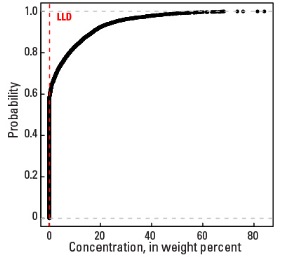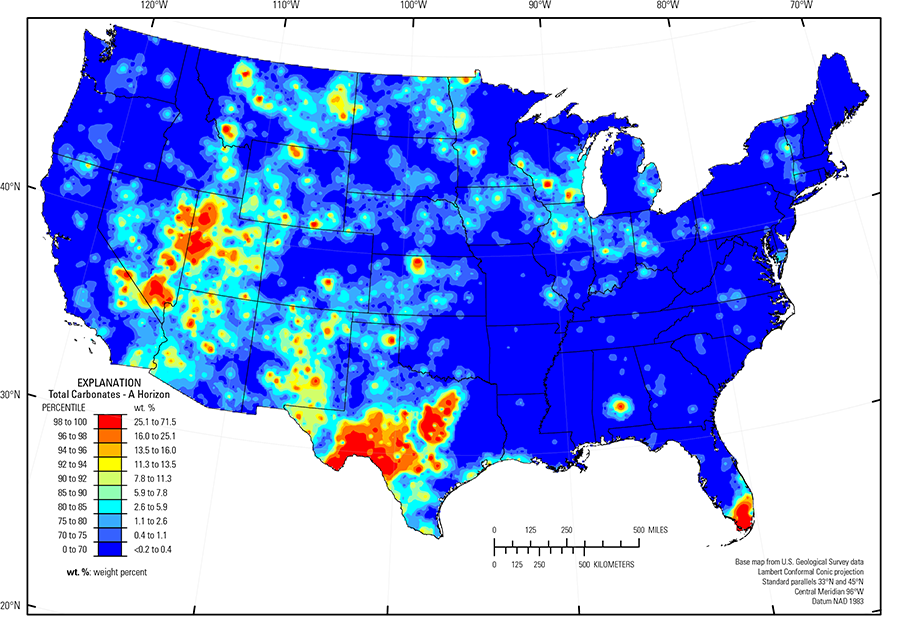
The purpose of these interpretive discussions is to provide a perspective on regional- and national-scale variations in element and mineral distributions in soils and their likely causes. The significant spatial variations shown by most elements and minerals can commonly be attributed to geologic sources in underlying parent materials, but other spatial variations seem clearly related to additional factors such as climate, the age of soils, transported source material, and anthropogenic influences. We attempt to distinguish the influence of these various factors on a regional and national scale. Numerous more local features might similarly be related to these same factors, but these features also have some probability of being an artifact of a random sampling of variable compositions, so that there is some probability of samples with similar compositions occurring in clusters of two or more adjacent sites by chance. Distinguishing such random occurrences from true variability is beyond the scope of the data from which these maps are constructed. Some caution, therefore, is advisable in interpreting the significance of these more local features unless some unique sources or processes can clearly be related to them.
Total Carbonate represents the sum of three carbonate minerals —calcite, a common mineral composed of calcium (Ca) and carbonate (CO3); dolomite, a white to gray Ca and magnesium (Mg) carbonate mineral; and aragonite, a less common calcium (Ca) carbonate mineral chemically identical to calcite but with a different crystal structure. The occurrence of carbonate minerals in soils is complex. Primary calcite in soil may be inherited from carbonate–bearing parent materials and secondary calcite may develop through leaching and redeposition, with the process dependent on biologic, physical, and climatic factors. Most dolomite in soils originates from dolomite–bearing parent materials. Development of primary dolomite in the soil environment is rare, although dolomite may form by precipitation in saline lakes. Aragonite can form through biological processes, such as deposition in mollusk shells, and by direct chemical precipitation in marine and freshwater settings.
Carbonate–rich soil parent materials can include limestone, dolostone, fossiliferous chalk or marl, and other marine sedimentary rocks, such as calcareous shale. Unconsolidated sediments derived from carbonate–bearing parent bedrock, such as alluvial, eolian, or glacial deposits, may also contain carbonate minerals. Calcareous soils in arid and semiarid areas not directly underlain by carbonate bedrock probably result from atmospheric deposition of fine CaCO3 particles or through the influx of Ca2+ dissolved in rainfall (Machette, 1985). Carbonate minerals are variably soluble in water and will be dissolved by infiltrating rainwater or groundwater. In humid climates, most carbonate minerals dissolve and constituents are leached from the soil profile. Many soils in arid and semiarid environments are calcareous as the lack of rainfall restricts leaching, creating secondary, pedogenic carbonate layers (dominantly calcite with perhaps minor dolomite or aragonite).
In our data, the total carbonate concentration in the soil C horizon ranges from below the detection limit of 0.2 weight percent (wt. %) to 84.1 wt. %, with more than 55 percent of the sites across the conterminous United States containing little or no carbonate minerals. Total carbonate in the soil A horizon ranges from less than 0.2 wt. % to 71.5 wt. %, with more than 70 percent of the sampled sites containing no detectable carbonate minerals (see the summary statistics [open in new window]).
The distribution of carbonate minerals in the soil C horizon largely reflects the presence of carbonate–bearing geologic parent materials. For example, soils in the Texas carbonate terrane developed on limestone, chalk, and dolostone, or unconsolidated deposits derived from carbonate bedrock. Chalk is also the parent material for soil containing calcite in the Alabama and Mississippi Blackland Prairie (USDA, 2006). Carbonate bedrock in central Nevada may be an original source of calcite in alluvial and lacustrine soils; however, many calcic soils develop from non–calcareous parent materials in arid to semiarid climate conditions (Machette, 1985). Calcareous eolian deposits in the Southern High Plains (northwestern Texas) and Rolling Plains and Breaks (USDA, 2006) across central Kansas contain calcite in deeper soil. In the Great Salt Lake Area (USDA, 2006), which includes the Bonneville Salt Flats, evaporation exceeds precipitation in restricted basins and a number of carbonate (calcite, aragonite) and evaporite (gypsum, halite) minerals precipitate in soil. Soil in the Everglades (USDA, 2006) developed in shallow freshwater biogenic marl forming on limestone bedrock. In this environment, the precipitation of CaCO3 may have been in the form of aragonite, which with time will recrystallize to calcite.
In the Great Lakes region, glacial materials derived from sedimentary carbonate rocks were distributed in the down–ice direction by glaciers. In the Upper Midwest, melting of glacial ice following late Wisconsinan period advances (16,000 to 12,000 years ago) left the region north of the southern glacial limit (Soller and others, 2012) mantled with a blanket of mixed, immature sediments, from which present–day soil developed. Individual ice lobes (Grimley, 2000) created distinct patterns in soil mineralogy because of varying provenance and ice transport paths. 'Gray' (carbonate– and shale–rich) till in the James and Des Moines lobes (Grimley, 2000) was derived from Cretaceous sedimentary rocks (dolostone, limestone, and shale). Gray tills were transported significant distances to the south and southeast from their source and deposited in areas underlain by Precambrian bedrock. 'Red' quartz– and feldspar–rich till deposited in northeastern Minnesota, northern Wisconsin and northwestern Michigan, have a Precambrian provenance with no material derived from carbonate bedrock. Soil in eastern Wisconsin, northern Illinois, northern Indiana, and Ohio developed on carbonate– and shale–bearing till sourced from sedimentary bedrock. Distinct boundaries in the soil C horizon map along the southern glacial limit (Soller and others, 2012), and between 'gray' and 'red' till clearly separate soil containing calcite and dolomite from soil with no detectable carbonate minerals. A notable feature of soils in glaciated areas of South Dakota, Minnesota, Michigan, Indiana, and Ohio, is that carbonate minerals are present in much lower concentration in the soil A horizon compared to the soil C horizon. Over the past 12,000 years since the soil parent material was deposited by glaciers, carbonate minerals have been leached from the soil A horizon but remain in the soil C horizon.
Statistics - 0 TO 5 CM
Statistics - A Horizon
| Number of samples | 4,802 |
| LLD | 0.2 wt. % |
| Number below LLD | 3,475 |
| Minimum | <0.2 wt. % |
| 5 percentile | <0.2 wt. % |
| 25 percentile | <0.2 wt. % |
| 50 percentile | <0.2 wt. % |
| 75 percentile | 0.4 wt. % |
| 95 percentile | 13.5 wt. % |
| Maximum | 71.5 wt. % |
| MAD | |
| Robust CV |
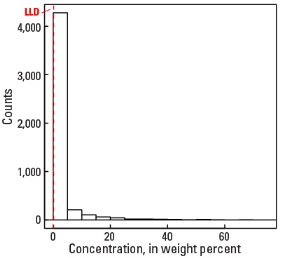
Histogram
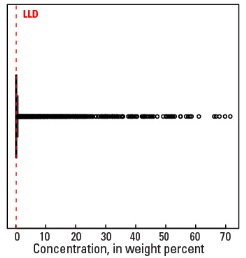
Boxplot
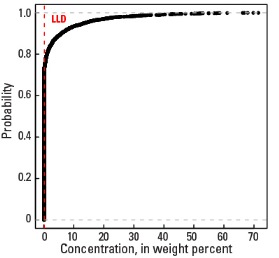
Empirical cumulative distribution function
Statistics - C Horizon
| Number of samples | 4,773 |
| LLD | 0.2 wt. % |
| Number below LLD | 2,796 |
| Minimum | <0.2 wt. % |
| 5 percentile | <0.2 wt. % |
| 25 percentile | <0.2 wt. % |
| 50 percentile | <0.2 wt. % |
| 75 percentile | 5.0 wt. % |
| 95 percentile | 25.9 wt. % |
| Maximum | 84.1 wt. % |
| MAD | |
| Robust CV |
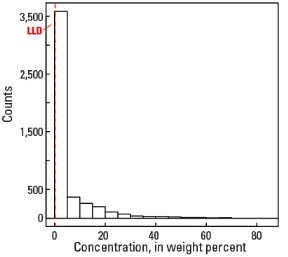
Histogram
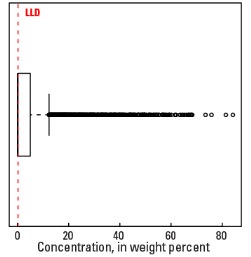
Boxplot
